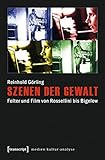Szenen der Gewalt : Folter und Film von Rossellini bis Bigelow / Reinhold Görling.
Material type: TextSeries: Medienkulturanalyse ; 7Publisher: Bielefeld : transcript Verlag, [2014]Copyright date: ©2014Edition: 1. AuflDescription: 1 online resource (216 p.)Content type:
TextSeries: Medienkulturanalyse ; 7Publisher: Bielefeld : transcript Verlag, [2014]Copyright date: ©2014Edition: 1. AuflDescription: 1 online resource (216 p.)Content type: - 9783837626544
- 9783839426548
- 791.436552 22/ger
- online - DeGruyter
| Item type | Current library | Call number | URL | Status | Notes | Barcode | |
|---|---|---|---|---|---|---|---|
 eBook
eBook
|
Biblioteca "Angelicum" Pont. Univ. S.Tommaso d'Aquino Nuvola online | online - DeGruyter (Browse shelf(Opens below)) | Online access | Not for loan (Accesso limitato) | Accesso per gli utenti autorizzati / Access for authorized users | (dgr)9783839426548 |
restricted access online access with authorization star
http://purl.org/coar/access_right/c_16ec
Gewalt entstellt und zerstört das Opfer, es nimmt ihm seinen Ausdruck. Doch wird auch das Subjekt nur sichtbar in einem performativen Prozess, in dem es in Beziehung mit anderen einen Ausdruck findet. Im Bild der Folter hat der Film diese Grenze der Sichtbarkeit immer wieder thematisiert.Der moderne Film selbst wird in einer Szene geboren, wie Serge Daney einmal gesagt hat: in der Darstellung der Folter vor einem Dritten in Rossellinis »Roma città aperta«. Reinhold Görling verfolgt diese Szene der Gewalt von Rossellini über Orwell, Pasolini, Beckett, Marker, Polanski, Hooper, McQueen u.a. bis zu Oppenheimer, Morris und Bigelow.
Torture and other forms of extreme violence threaten the ascertainable intermediate spaces of media in which the subject negotiates the respective differences between sensation and community, autonomy and language, binding and trauma, and obsession and distance. Reinhold Görling shows that because the history of (the phantasms of) torture is a history of the political structure of these intermediate spaces, the story of the cinematic depiction of torture is also a story of media. He pursues these relationships in four perspectives - sensation, face, reconciliation, image - from Rossellini's Roma città aperta up to Bigelow's Zero Dark Thirty.
Mode of access: Internet via World Wide Web.
In German.
Description based on online resource; title from PDF title page (publisher's Web site, viewed 01. Nov 2023)


